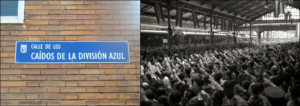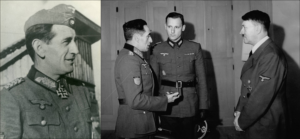Nazi collaborator monuments in Spain
On Feb. 13, 2021, 300 neo-Nazis marched in Madrid to commemorate a battle fought by the Blue Division, a formation of Spanish volunteers who fought for the Third Reich

Left: Blue Division soldiers in the Soviet Union, 1943 (Wikimedia Commons). Right: neo-Nazi rally organized by Juventud Patriota de Madrid, Madrid, February 13, 2021 (Screenshot/YouTube). Image by Forward collage
This list is part of an ongoing investigative project the Forward first published in January 2021 documenting hundreds of monuments around the world to people involved in the Holocaust. We are continuing to update each country’s list; if you know of any not included here, or of statues that have been removed or streets renamed, please email [email protected], subject line: Nazi monument project.

Madrid and six other locales — A street named in honor of the fallen soldiers of the Blue Division (250th Infantry Division) a formation of Spanish volunteers who fought for the Third Reich. Spain was officially neutral during WWII, but its dictator Francisco Franco permitted the recruitment of volunteers for the German army under the stipulation they be deployed against the Soviet Union and not against Western Europe (Franco did not want his Western European neighbors to think Spain had broken its neutrality). Over 45,000 collaborators fought in the Blue Division over the course of the war.
Madrid’s Blue Division Street has been at the center of legal battles to rename it. The latest challenge attempted using a 2007 historical memory law which bans glorification of Francoism. Ironically, the court permitted the name to remain because it considered the Blue Division as a Nazi and not a Francoist formation. Coverage in El Diario (Google translation here). Above right, Blue Division members, 1942.
Several Spanish cities have renamed their Blue Division streets, but the unit still has ones in Belmonte, Jerez de la Frontera, La Alberca de Záncara, La Carolina and Villalpardo. There’s also a strange monument, ostensibly to a Blue Division veteran, in the village of Carrascal del Obispo; the monument contains not only Blue Division insignia but also the berkenkruis (“birch cross”) which is a symbol of Flemish Nazi collaborator formations (see the Belgium section for more.)

Update (January 2023): The Muñoz Grandes boarding house has been renamed.
Guadarrama and four other locales — A street for Agustín Muñoz Grandes (1896–1970), Spanish Civil War general who became the Blue Division’s commander. While serving the Nazis, Muñoz Grandes received the Iron Cross and the Knight’s Cross of the Iron Cross with Oak Leaves (Nazi Germany’s highest military honor he was personally awarded by Hitler). Above right, Muñoz Grandes with Hitler, 1942.
Muñoz Grandes has additional streets in El Boalo, Juneda and Los Belones. He also had a boarding house in Barcelona. Initially an army dormitory established by the general, the house was taken over by a private company in 2015. See coverage in El País (Google translation here).
Neo-Nazis in many nations use WWII anniversaries as focal points for rallies (see the Estonia, Hungary and Ukraine sections). Spain is no different – on February 13, 2021, 300 neo-Nazis marched in Madrid to commemorate a battle fought by the Blue Division (below right). The annual march was organized by the neo-Nazi group Juventud Patriota de Madrid (Patriotic Youth of Madrid). “The Jew is the culprit,” proclaimed a speaker. See coverage in The Olive Press and The Algemeiner; press release by the European Jewish Congress.

Correction: An earlier version of this article misreported the location of the boarding house named after Muñoz Grandes. It was in Barcelona, not Madrid.

















